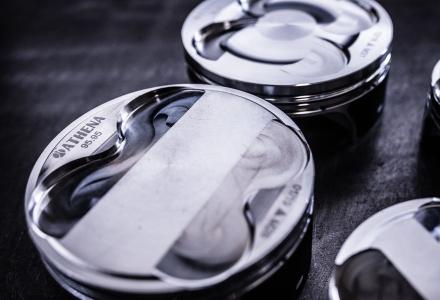Engine Valves: Issues, Adjustment, and Failure Symptoms
Engine valves are crucial components in ensuring the proper sequence of the four stages of a four-stroke engine's operation: intake, compression, combustion, and exhaust. Internal combustion engines feature primarily two types of valves: the intake and the exhaust valves. Each cylinder may be equipped with two or more valves, up to five valves per cylinder.
What Are Engine Valves, What Do They Do, and How Do They Work?
Every 4-stroke internal combustion engine features engine valves located on the cylinder head. They have the crucial task of regulating the flow of the air and fuel mixture into and out of the engine.
These engine valves resemble an inverted mushroom, featuring a truncated conical seal around the circumference that sits on a ring-shaped valve seat in the cylinder head. A stem extends from the valve, sliding inside a guide in the head. At the stem's end are valve split collets, which are in the cup and engage with the return spring. The engine valves are connected to the return springs and the camshaft (linked in turn to the crankshaft) and these two elements control their operation. As they rise and fall, the engine valves open and close the intake and exhaust ports of the cylinder head, allowing the air and fuel mixture to enter the combustion chamber while the piston is moving towards the BDC (Bottom Dead Center) and, after combustion, allowing the burnt mixture to exit as the piston returns to the TDC (Top Dead Center).
Motorcycle engine valves should not be confused with the throttle valve, which regulates the amount of air drawn in, nor with the exhaust valves: the latter, also known as backpressure valves or exhaust control valves, are specific types of gate valves found in 2-stroke engines. They are used to modify the strength of the backpressure wave of the resonating exhaust and/or the opening of the exhaust port depending on usage conditions.

The Most Common Motor Valve Issues
Like other engine components, valves too can wear out. Defective, worn, or simply dirty engine valves can seize, crack or develop fissures, leading to engine power loss.
The most common issue arises from the build-up of dirt near the valve seats: residues of fuel and oil create a rough, blackish coating. The primary reasons for this issue can be unsuitable driving styles, frequent stop-and-go, direct injection that no longer produces a rinsing effect, exhaust gas recirculation, or engine oil fumes. Over time, the build-up of materials like rubber and plastic can lead to improper valve closure: this causes the gases to overheat the load plate, resulting in its burning.
Other issues related to valves can be due to:
- Wear;
- Combustion issues;
- Assembly and adjustment errors (such as incorrect valve clearance adjustment, improper spring or hydraulic tappet installation);
- Manufacturing errors (misalignment on the valve seat ring or guide, excessive or insufficient valve guide clearance);
- Installation of worn parts such as the use of worn valve split collets (issues not immediately visible).

Motor Valve Failure: Symptoms and What to Do
Issues with intake valves can lead to poor combustion, compromising the proper operation of the vehicle over time and reducing its performance. The indicators of valve issues include noise (ticking), loss of power, any ignition difficulties, high fuel consumption, and excessive smoke from the exhaust.
Removing and replacing the engine valves is not a task for anyone. The main check is for valve seal integrity, without which clean combustion cannot occur. Initially, valve wear leads to high oil consumption, worsening motorcycle performance, and over time, heat in the combustion chamber can damage other engine parts.
Symptoms of damaged valves are not always easy to recognize, as the damage can vary depending on the cause and the defect that shows up. Key elements to watch for are a loss of power or any unusual noises from the engine, particularly metallic ticking.

Motor Valve Ticking: Recognizing Engine Noise
Motor valve ticking is one of the most easily recognizable indicators of issues. A cyclic metallic noise, which could be described as clattering, is heard. This is a medium-to-high frequency sound from the top part of the engine, especially noticeable when the engine is idling and varying depending on engine speed.
How to Adjust Engine Valves
When the valves are closed, or in a resting position, they must ensure perfect seal. This is especially crucial to prevent combusted gas from escaping during the expansion phase after ignition. The challenge lies in maintaining seal regardless of the engine speed and, most importantly, the temperature.
To prevent the valve from remaining open due to the natural expansion of the metal with increasing temperature, a (minimal) gap is necessary between the end of the valve stem and the rocker. In some cases, instead of the rocker, there are inverted cup-shaped tappets in direct contact with the camshaft. In this scenario, the gap must be between the camshaft and the tappets. This gap is defined as motor valve clearance. In other words, motor valve clearance is the space that must exist between the camshaft and the tappet.
Checking the motor valve clearance is one of the most important maintenance tasks. It is performed to avoid excessive noise due to too much clearance and to prevent any risk of motor valve seizing or even burning. If the measured clearance does not match the manufacturer's specifications (as listed in the service manual), the engine valves have to be adjusted.
Motor valve clearance measurements should be done with a cold engine, cylinder by cylinder, after positioning the piston at top dead center and aligning the cam lobes, each in the opposite direction from the other.
The check is typically carried out using feeler gauges, but nowadays, more accurate laser technology tools are also available for this measurement.
If the motor valve clearance is too narrow, there will be deterioration of the valve seats and valves. In the case of the intake valve, the necessary air-fuel mixture will not be adequately drawn in, while for the exhaust valve, the engine will tend to backfire more often.
On the other hand, if there is too much clearance, there will be a delay in the motor valve's opening and early closing (during the closing phase), leading to a consequent loss of power.
Each valve has its own clearance, and there is no correlation between the clearance of one valve and that of the others.

Engine Valve Cleaning: Maintenance Tips
Can engine valves and intake ports be cleaned? Fortunately, yes: in addition to the "traditional" solution, which involves disassembling the components for mechanical abrasion or even grinding, it is also possible to use additives and sprays. However, this solution may not always be effective, especially in cases where there is heavily crystallized soiling.
To ensure that the engine valves of your motorcycle last as long as possible, our advice is to use high-quality fuels and lubricants, always keep the carburation finely tuned, follow the maintenance intervals recommended by the manufacturer, and avoid thermally stressing the engine as much as possible.
Athena offers a wide range of engine valves on its website, including intake and exhaust valves for 4-stroke engines, as well as complete kits for engine valve replacement in 2-stroke engines, such as the one for the Big Bore Cylinder Kit. These are suitable for both street bikes and cross/off-road motorcycles. Each kit includes a compatibility list showing the motorcycle models for which it is suitable.
Allegati




